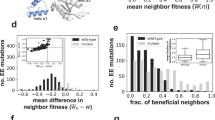Abstract
Continuous in vitro evolution methods were used to study the behavior of an evolving population of RNA ligase ribozymes in response to selection pressures involving conditions of extreme pH. The starting population consisted of randomized variants of a ribozyme that had been optimized for activity at pH 8.5. The ribozymes were subjected to repeated rounds of selective amplification under progressively more acidic or more alkaline conditions. The two final evolved populations of ribozymes were able to operate at either pH 5.8 or pH 9.8, respectively. Representative individuals from the two final populations were isolated and characterized. The low-pH ribozyme exhibited a 10-fold increase in catalytic rate at pH 5.8 compared to the starting molecule. The high-pH ribozyme retained its structural integrity and activity at pH 9.8, whereas the starting molecule was denatured under this condition. These findings demonstrate that a population of functional macromolecules can adapt to stringent environmental conditions through the acquisition of relatively few mutations. The results establish continuous in vitro evolution as a useful model system for exploring the evolution of enzymatic function in extreme environments.




Similar content being viewed by others
References
DP Bartel JW Szostak (1993) ArticleTitleIsolation of new ribozymes from a large pool of random sequences. Science 261 1411–1418 Occurrence Handle7690155
NH Bergman WK Johnston DP Bartel (2000) ArticleTitleKinetic framework for ligation by an efficient RNA ligase ribozyme. Biochemistry 39 3115–3123 Occurrence Handle10.1021/bi992654u Occurrence Handle10715133
RC Cadwell GF Joyce (1992) ArticleTitleRandomization of genes by PCR mutagenesis. PCR Methods Appl 2 28–33 Occurrence Handle1:CAS:528:DyaK3sXhs1Sr Occurrence Handle1490172
EH Ekland JW Szostak DP Bartel (1995) ArticleTitleStructurally complex and highly active RNA ligases derived from random RNA sequences. Science 269 364–370 Occurrence Handle7618102
EH Ekland DP Bartel (1996) ArticleTitleRNA-catalysed RNA polymerization using nucleoside triphosphates. Nature 382 373–376 Occurrence Handle1:CAS:528:DyaK28Xks1Wnsrg%3D Occurrence Handle8684470
SH Eom J Wang TA Steitz (1996) ArticleTitleStructure of Taq polymerase with DNA at the polymerase active site. Nature 382 278–281 Occurrence Handle10.1038/382278a0 Occurrence Handle8717047
W Gilbert (1986) ArticleTitleThe RNA world. Nature 319 618
WK Johnston PJ Unrau MS Lawrence ME Glasner DP Bartel (2001) ArticleTitleRNA-catalyzed RNA polymerization: Accurate and general RNA-templated primer extension. Science 292 1319–1325 Occurrence Handle1:CAS:528:DC%2BD3MXjvVGjsbg%3D Occurrence Handle11358999
GF Joyce (2002) ArticleTitleThe antiquity of RNA-based evolution. Nature 418 214–221 Occurrence Handle10.1038/418214a Occurrence Handle12110897
S Knapp WM de Vos D Rice R Ladenstein (1997) ArticleTitleCrystal structure of glutamate dehydrogenase from the hyperthermophilic eubacterium Thermatoga maritima at 3.0 Å resolution. J Mol Biol 267 916–932 Occurrence Handle1:CAS:528:DyaK2sXivFWks7w%3D Occurrence Handle9135121
RG Kroll (1990) Alkalophiles. EC Edwards (Eds) Microbiology of extreme environments. Open University Press Milton Keynes, UK 55–92
MT Madigan BL Marrs (1997) ArticleTitleExtremophiles. Sci Am 1997 82–87
KE McGinness MC Wright GF Joyce (2002) ArticleTitleContinuous in vitro evolution of a ribozyme that catalyzes three successive nucleotidyl addition reactions. Chem Biol 9 585–596 Occurrence Handle10.1016/S1074-5521(02)00136-9 Occurrence Handle12031665
Y Miyamoto N Teramoto Y Imanishi Y Ito (2001) ArticleTitleIn vitro adaptation of a ligase ribozyme for activity under low-pH condition. Biotechnol Bioeng 75 590–596 Occurrence Handle10.1002/bit.10033 Occurrence Handle11745135
P Ordoukhanian GF Joyce (1999) ArticleTitleA molecular description of the evolution of resistance. Chem Biol 6 881–889 Occurrence Handle1:CAS:528:DyaK1MXotVygsro%3D Occurrence Handle10631516
FG Pluthero (1993) ArticleTitleRapid purification of high-activity Taq DNA polymerase. Nucleic Acids Res 21 4850–4851 Occurrence Handle8233838
RJM Russell U Gerike MJ Danson DW Hough GL Taylor (1998) ArticleTitleStructural adaptations of the cold-active citrate synthase from an Antarctic bacterium. Structure 6 351–361 Occurrence Handle1:CAS:528:DyaK1cXisFSls7w%3D
C Schleper G Pühler B Kühlmorgen W Zillig (1995) ArticleTitleLife at extremely low pH. Nature 375 741–742 Occurrence Handle10.1038/375741b0
T Schmitt N Lehman (1999) ArticleTitleNon-unity molecular heritability demonstrated by continuous evolution in vitro. Chem Biol 6 857–869 Occurrence Handle10.1016/S1074-5521(00)80005-8 Occurrence Handle10631514
J-P Vartanian M Henry S Wain-Hobson (1996) ArticleTitleHypermutagenic PCR involving all four transitions and a sizeable proportion of transversions. Nucleic Acids Res 24 2627–2631 Occurrence Handle10.1093/nar/24.14.2627 Occurrence Handle8758987
MC Wright GF Joyce (1997) ArticleTitleContinuous in vitro evolution of catalytic function. Science 276 614–617 Occurrence Handle1:CAS:528:DyaK2sXivVKis7c%3D Occurrence Handle9110984
Acknowledgements
This work was supported by Grant NAG5-9386 from the National Aeronautics and Space Administration and The Skaggs Institute for Chemical Biology.
Author information
Authors and Affiliations
Corresponding author
Rights and permissions
About this article
Cite this article
Kühne, H., Joyce, G.F. Continuous In Vitro Evolution of Ribozymes That Operate Under Conditions of Extreme pH . J Mol Evol 57, 292–298 (2003). https://doi.org/10.1007/s00239-003-2480-z
Received:
Accepted:
Issue Date:
DOI: https://doi.org/10.1007/s00239-003-2480-z




